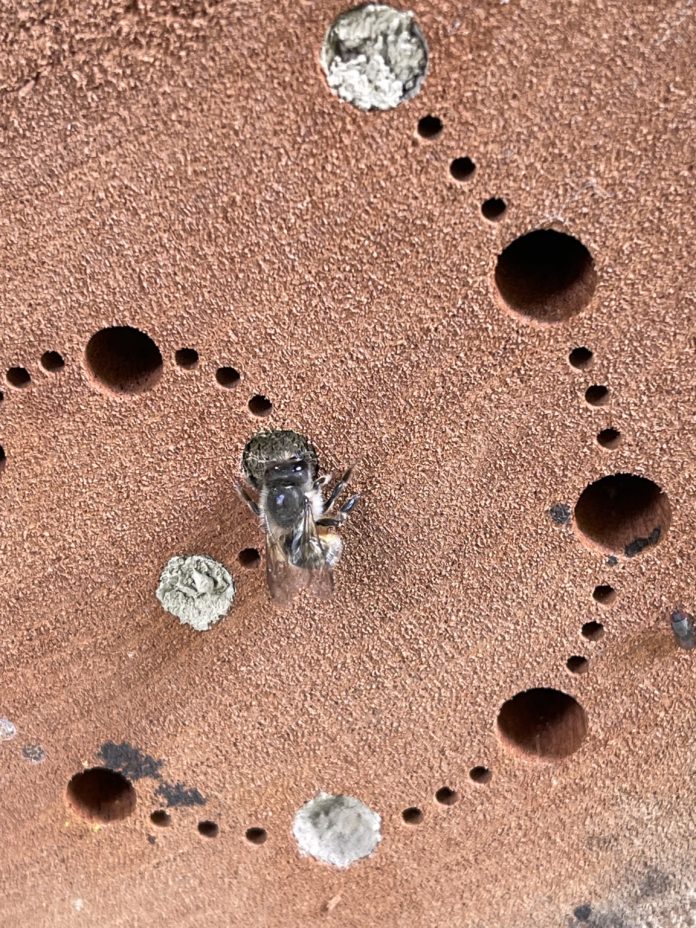Surprising Information about Bees
In April, the Garden Club met at Mission Hills Nursery to hear Candace Vanderhoff from Solobee tell us the truth about bees. I assumed that most of our food is directly or indirectly dependent on the European honeybees’ pollination. We learned from Vanderhoff that the European honeybee is threatening our native bee population by bullying them and taking their precious resources, the pollen they feed their young. Whoever heard of our gentle and colorful solitary native bees?
There are over 20,000 bee species in the world, “Seven species are honeybees,” Vanderhoff explained, “while the rest of the other 20,000 are solitary, which means most bees live alone. The vast majority of bees are one single bee, living all alone, not in a hive or swarm.” In the United States we have 4,000 species of solitary native bees; San Diego is home to 700 species of solitary native bees. Vanderhoff continued, “The entire state of Florida has 200 species. San Diego is a biodiversity hotspot; we are blessed with many different bees.” The imported European honeybee is actually an invasive species, threatening the existence of our native bees.
Vanderhoff pointed out that “over 80 per cent of our plants require pollination; one in three bites of what we eat requires pollination.” Honeybees travel about five miles to collect their pollen which they gather on their legs and deliver to the hive to make honey. Unlike the far-traveling honeybee, native bees collect pollen from about a 200-foot radius. This they collect by rolling in it; every bit of their furry bodies is covered. The pollen is dropped in their tunnels to feed their larvae. Ultimately, their short radius keeps them in local gardens, making the native bee one hundred times better than the honeybee at pollination.
Native bees come in all shapes and colors and sizes. Some could fit on the head of a pin whereas others may be the size of a kumquat. These native bees use their stingers to lay eggs, rarely stinging as most cannot even penetrate human skin and are too tiny to hurt. Male bees do not have a stinger since they do not lay eggs. Since native bees are solitary, they have no need to defend a communal hive. Some of the most useful of our native bees are leafcutter bees, mason bees, and digger bees. Many of these solitary bees make their nests in tunnels in rotting trees, in stems, or in the ground; they like dark cavernous tunnels where they know their eggs will be safe.
Vanderhoff knew we needed bees, but learning how much more efficient our native bees are at pollination than the European honeybees are led to her creating bee houses. She wanted to make a beautiful nesting shelter so any backyard gardener could help their local native bees. Drilling deep holes in blocks of recycled wood mimics the abandoned beetle tunnel for which bees search in nature. These are the “tunnels” which the tunneling variety of bee will line with mud.
In spring, newly mated females may search for a wood tunnel; they may dig a new tunnel in the ground. Carpenter bees are the only bees that can carve their own tunnels; most bees search for a cavity. Over the next six to eight weeks, the female will lay about 35 eggs. If the tunnels are deep enough, she may fill three tunnels. Within each tunnel, the eggs containing future female bees are laid at the back of the tunnels; the males are at the front. To provide sustenance for the babies once they become larvae, the mama bee then forages for nectar and pollen which she will mix, making it into paste balls, and leaving them in the tunnels where newly hatched larvae can find them. Her final act is to seal the tunnels with mud. Once she has laid all her eggs, she dies.
The eggs develop through the same stages as other insects: egg, larva, pupa, adult. By August these eggs will be adults. They may hibernate, overwintering in the tunnels. Some eggs overwinter in the tunnel and pupate in spring.
Since the male bee’s only function is to fertilize the female’s eggs, male bees typically only live for a day. The females live six to eight weeks, although they may spend as much as a year in a suspended development called diapause.
Vanderhoff told us that creating a backyard native plant habitat is essential to helping San Diego’s 700 species of native bees. Over millennia, native bees have evolved with native plants, creating the beautiful ecosystem from which we all benefit today. While people are eager to help honeybees, it is the native bees that are in steep decline and that pollinate many of our native plants which honeybees do NOT pollinate.
To create a habitat garden, you need to begin by adding native flowering plants. Native plants should attract native bees. Then make a bee’s drinking pond with stones set in a dish of water. Do not use any pesticides, or chemical; only use organic fertilizers. To provide shelter, you might consider buying a bee house from Candace who worked with an entomologist to perfect her design. Vanderhoff offers classes where you can build your own bee house. Put it in a sunny spot no more than six feet above the ground. Then wait. Go to SoloBee.com for more information.
If you haven’t joined the Mission Hills Garden Club, join now, or renew your membership. You will collect all sorts of helpful ideas, you’ll meet really nice people, and it is a chance to give to your community. Mission Hills Nursery gives a ten per cent discount to members. You don’t need to be a gardener; being curious is enough. It costs $35 for a single membership and $50 for a family. The next Garden Club Meeting will be in September.

Category: Animals, Education, Food, Gardening, Local News, Plants







